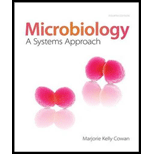
Microbiology: A Systems Approach
4th Edition
ISBN: 9780073402437
Author: Marjorie Kelly Cowan Professor
Publisher: McGraw-Hill Education
expand_more
expand_more
format_list_bulleted
Question
Chapter 16.4, Problem 12AYP
Summary Introduction
To enlist:
The commonalities and differences between type II and type III hypersensitivities.
Concept introduction:
Hypersensitivity refers to immune reactions produced by the normal immune system, such as allergies and autoimmunity. They are referred as an over-reaction immune system and these reactions are damaging, discomforting, and sometimes can even be fatal.
Expert Solution & Answer
Want to see the full answer?
Check out a sample textbook solution
Students have asked these similar questions
How do I determine the inhertiance pattern from the pedigree diagram?
its an open book assignemnt
Describe two different gene regulation mechanisms involving methylation
Chapter 16 Solutions
Microbiology: A Systems Approach
Ch. 16.1 - Define immunopathology, and describe the two major...Ch. 16.1 - Prob. 2AYPCh. 16.2 - Prob. 3AYPCh. 16.2 - Outline the steps of a type I allergic response,...Ch. 16.2 - Identify three conditions caused by IgE-mediated...Ch. 16.2 - Prob. 6AYPCh. 16.2 - Prob. 7AYPCh. 16.2 - Prob. 8AYPCh. 16.3 - Prob. 2CFCh. 16.3 - List the three immune components causing cell...
Ch. 16.3 - Prob. 10AYPCh. 16.3 - Prob. 11AYPCh. 16.4 - Prob. 12AYPCh. 16.4 - Prob. 13AYPCh. 16.5 - Prob. 14AYPCh. 16.5 - List four classes of grafts, and explain how host...Ch. 16.6 - Prob. 16AYPCh. 16.6 - Prob. 17AYPCh. 16.7 - Prob. 18AYPCh. 16.7 - Prob. 19AYPCh. 16.7 - Prob. 20AYPCh. 16 - Prob. 1CFCh. 16 - Prob. 1MCQCh. 16 - Prob. 2MCQCh. 16 - The contact with allergen that results in symptoms...Ch. 16 - Prob. 4MCQCh. 16 - Prob. 5MCQCh. 16 - Prob. 6MCQCh. 16 - Prob. 7MCQCh. 16 - Prob. 8MCQCh. 16 - Prob. 9MCQCh. 16 - Prob. 10MCQCh. 16 - Prob. 11TFCh. 16 - Prob. 12TFCh. 16 - Prob. 13TFCh. 16 - Prob. 14TFCh. 16 - Prob. 15TFCh. 16 - Prob. 1CTQCh. 16 - Prob. 2CTQCh. 16 - Prob. 3CTQCh. 16 - Prob. 4CTQCh. 16 - Prob. 5CTQCh. 16 - Prob. 6CTQCh. 16 - Prob. 7CTQCh. 16 - Prob. 8CTQCh. 16 - Prob. 9CTQCh. 16 - Prob. 10CTQCh. 16 - Prob. 1CCCh. 16 - Prob. 2CCCh. 16 - Prob. 3CCCh. 16 - From chapter 15. figure 15.1. How would a persons...Ch. 16 - Prob. 2VCCh. 16 - Prob. 1CM
Knowledge Booster
Similar questions
- What is behavioral adaptarrow_forward22. Which of the following mutant proteins is expected to have a dominant negative effect when over- expressed in normal cells? a. mutant PI3-kinase that lacks the SH2 domain but retains the kinase function b. mutant Grb2 protein that cannot bind to RTK c. mutant RTK that lacks the extracellular domain d. mutant PDK that has the PH domain but lost the kinase function e. all of the abovearrow_forwardWhat is the label ?arrow_forward
- Can you described the image? Can you explain the question as well their answer and how to get to an answer to an problem like this?arrow_forwardglg 112 mid unit assignment Identifying melting processesarrow_forwardGive only the mode of inheritance consistent with all three pedigrees and only two reasons that support this, nothing more, (it shouldn't take too long)arrow_forward
- Oarrow_forwardDescribe the principle of homeostasis.arrow_forwardExplain how the hormones of the glands listed below travel around the body to target organs and tissues : Pituitary gland Hypothalamus Thyroid Parathyroid Adrenal Pineal Pancreas(islets of langerhans) Gonads (testes and ovaries) Placentaarrow_forward
- What are the functions of the hormones produced in the glands listed below: Pituitary gland Hypothalamus Thyroid Parathyroid Adrenal Pineal Pancreas(islets of langerhans) Gonads (testes and ovaries) Placentaarrow_forwardDescribe the hormones produced in the glands listed below: Pituitary gland Hypothalamus Thyroid Parathyroid Adrenal Pineal Pancreas(islets of langerhans) Gonads (testes and ovaries) Placentaarrow_forwardPlease help me calculate drug dosage from the following information: Patient weight: 35 pounds, so 15.9 kilograms (got this by dividing 35 pounds by 2.2 kilograms) Drug dose: 0.05mg/kg Drug concentration: 2mg/mLarrow_forward
arrow_back_ios
SEE MORE QUESTIONS
arrow_forward_ios
Recommended textbooks for you
 Human Physiology: From Cells to Systems (MindTap ...BiologyISBN:9781285866932Author:Lauralee SherwoodPublisher:Cengage Learning
Human Physiology: From Cells to Systems (MindTap ...BiologyISBN:9781285866932Author:Lauralee SherwoodPublisher:Cengage Learning Human Biology (MindTap Course List)BiologyISBN:9781305112100Author:Cecie Starr, Beverly McMillanPublisher:Cengage Learning
Human Biology (MindTap Course List)BiologyISBN:9781305112100Author:Cecie Starr, Beverly McMillanPublisher:Cengage Learning


Human Physiology: From Cells to Systems (MindTap ...
Biology
ISBN:9781285866932
Author:Lauralee Sherwood
Publisher:Cengage Learning



Human Biology (MindTap Course List)
Biology
ISBN:9781305112100
Author:Cecie Starr, Beverly McMillan
Publisher:Cengage Learning
